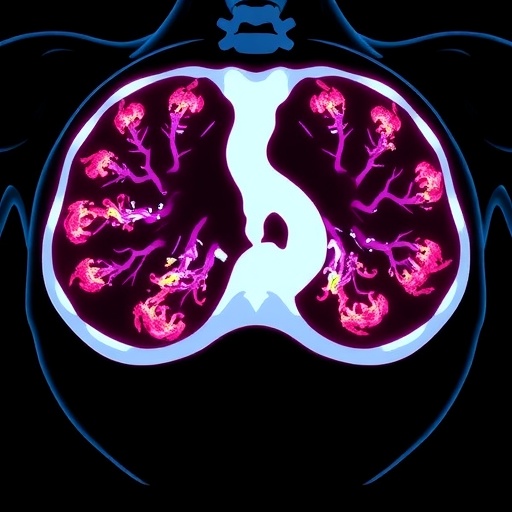In a groundbreaking study that sheds light on the often overlooked domain of central nervous system (CNS) prophylaxis in primary testicular lymphoma (PTL), researchers Liu, Yang, and Zhao have embarked on a comprehensive analysis showcasing the survival outcomes of patients subjected to various prophylactic measures. Conducted across multiple centers, this real-world investigation stands at the forefront of oncological research, engendering discussions about treatment protocols that could enhance survival rates. The findings presented in their article provide crucial insights into the complexities of lymphatic malignancies and reinforce the necessity for nuanced treatment strategies.
Primary testicular lymphoma is an infrequent yet aggressive cancer that primarily affects elderly men. Traditionally characterized by a high propensity for CNS metastasis, PTL poses significant therapeutic challenges. The intricate nature of the disease demands an in-depth exploration of the treatment regimens that not only address the neoplasm at its origin but also mitigate the risk of systemic spread, particularly in the CNS, a critical area often associated with poor prognosis. This study endeavors to examine the implications of CNS prophylaxis, an approach aimed at preventing tumor spread to the brain and spinal cord.
The central premise of this groundbreaking research pivots around the role of CNS prophylaxis in improving longitudinal outcomes for patients diagnosed with PTL. CNS involvement in PTL can dramatically influence survival rates, leading to an urgent call for effective preventative measures. Liu and colleagues meticulously mapped the survival rates of patients receiving CNS prophylaxis compared to those who did not. Their findings suggest a significant correlation between prophylactic treatment and enhanced outcomes, suggesting that medical practitioners should reconsider traditional treatment paradigms.
Utilizing a simplified Burkitt Lymphoma (BL) model as a benchmark, the research team sought to establish a more refined understanding of predictive factors that govern patient prognosis in the realm of lymphoproliferative disorders. This simplified model stands as a pivotal tool to unravel the complexities associated with treatment responses in PTL, advocating for the adoption of a more tailored approach to patient management. By critically analyzing various demographics and treatment responses, this study underscores the heterogeneity that characterizes PTL and dismisses the one-size-fits-all philosophy often deployed in oncological practice.
Real-world data is invaluable in large-scale cancer studies, and this multicenter approach harnesses the power of diverse patient populations, thereby enhancing the validity of the findings. The integration of data from multiple reputable institutions enriched the analysis, allowing for a comprehensive understanding of treatment efficacy across varied clinical settings. The predictive outcomes derived from this collective dataset reveal alarming discrepancies in survival rates, emphasizing the dire consequences that underscore inadequate treatment strategies, especially the absence of CNS prophylaxis.
A key element of this study lies in its exploration of how CNS prophylaxis impacts not only long-term survival but also quality of life among patients. It is well-documented that patients enduring aggressive treatment regimens often grapple with the ramifications of their therapies long after cessation. Therefore, understanding the balance between maximizing survival while minimizing debilitating side effects is quintessential. By adhering to a set of well-defined parameters, the authors articulated facets of care that improve overall patient experiences while enhancing survival odds.
Throughout their investigation, Liu et al. deftly navigated the intricacies of treatment complications that arise with the application of modern therapeutics. The evolving landscape of cancer treatment, especially in lymphoproliferative diseases, necessitates continuous research to identify optimal timing and combinations of treatment modalities. Specifically, the study recognized that while conventional chemotherapy regimens form the backbone of treatment, the integration of CNS prophylaxis poses additional layers of complexity that must be navigated carefully.
Moreover, this essential investigation holds broader implications for future research in oncology. The findings advocate for a paradigm shift in how researchers and clinicians perceive and address primary testicular lymphoma. As innovative approaches to cancer treatment continue to emerge, understanding the nuanced details pertaining to CNS prophylaxis and its ramifications on treatment pathways is invaluable for both current clinical applications and future research endeavors.
Deterministically, a careful reevaluation of PTL treatment protocols in light of the results yielded by this study is warranted. As life expectancy and survivorship continue to increase in oncology, it becomes incumbent upon practitioners to integrate proactive strategies that ensure optimal long-term outcomes. The authors passionately argue that neglecting CNS prophylaxis can have dire implications, advising clinicians to adjust protocols that incorporate CNS-directed therapies too.
The implications of this research extend well beyond the immediate scope of PTL, tapping into the foundations of oncological therapy. Additionally, the study thoughtfully opens avenues for subsequent research to investigate the broader applications of CNS prophylaxis in other malignancies with similar propensities for CNS metastasis. The consistency of findings across varied cancer types can forge new standards of care that prioritize not only survival but enriched patient wellness throughout the arc of their treatment journey.
Furthermore, this research serves as a clarion call to the cancer research community, signaling a critical need for ongoing studies focused on patient-centric outcomes. The dialogue initiated by Liu and colleagues positions CNS prophylaxis as a necessary consideration in contemporary trials and clinical practice. In an era where personalized medicine is gaining traction, their findings compel researchers to delve deeper into patient stratification, aiming to construct bespoke treatment regimens that align with individual patient needs.
As our understanding of malignancies refines, the articulation of new hypotheses stemming from this research will undoubtedly challenge existing treatment frameworks. The multifaceted nature of lymphoma management continues to evolve; thus, continual refinement of treatment protocols in alignment with emerging evidence is imperative. The dialogue initiated by this study will hopefully propel further studies that refine our approaches to CNS involvement in lymphomas.
In conclusion, Liu et al.’s investigation into CNS prophylaxis’s prognostic impact in PTL reveals vital insights for clinical practice and research alike. The clear association between CNS prophylaxis and improved patient outcomes provides robust justification for integrating these measures into standard treatment protocols. By recognizing the dynamic interplay between treatment efficacy and patient-centered care, this research contributes significantly to evolving standards of oncological treatment and underscores the need for ongoing exploration in this critical area of study.
Subject of Research: Prognostic impact of central nervous system prophylaxis in primary testicular lymphoma.
Article Title: Prognostic impact of central nervous system prophylaxis and a simplified BL model in primary testicular lymphoma: a real-world multicenter study.
Article References:
Liu, S., Yang, P., Zhao, Y. et al. Prognostic impact of central nervous system prophylaxis and a simplified BL model in primary testicular lymphoma: a real-world multicenter study.
J Cancer Res Clin Oncol 151, 307 (2025). https://doi.org/10.1007/s00432-025-06358-9
Image Credits: AI Generated
DOI:
Keywords: Primary testicular lymphoma, central nervous system prophylaxis, Burkitt Lymphoma, prognostic outcomes, oncological treatment strategies.
Tags: aggressive cancer in elderly menbrain and spinal cord tumor preventionCNS metastasis in testicular cancerCNS prophylaxis in primary testicular lymphomaenhancing survival rates in lymphoma patientsimplications of CNS cancer preventionlymphatic malignancies researchnuanced treatment strategies for PTLreal-world investigation of lymphoma treatmentsurvival outcomes in testicular lymphomatherapeutic challenges in primary testicular lymphomatreatment protocols for lymphatic malignancies





